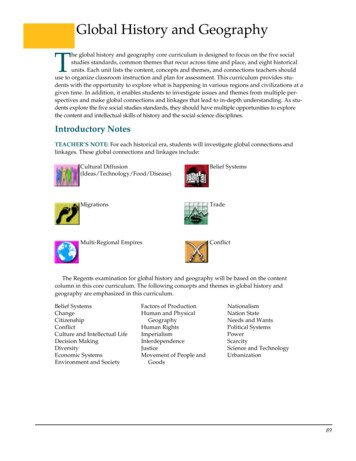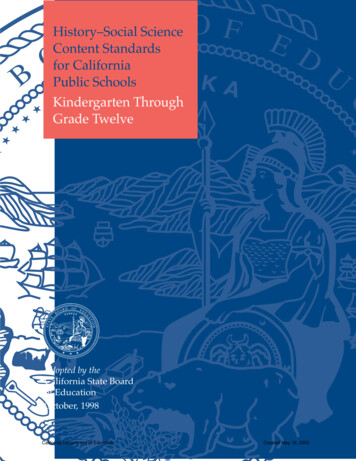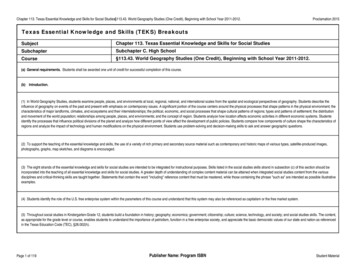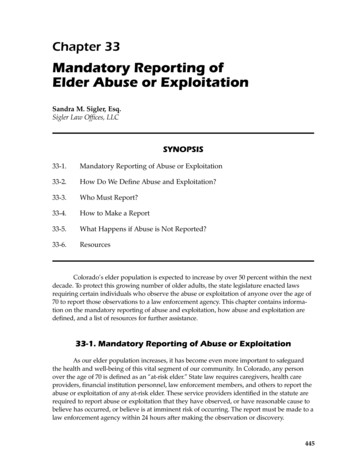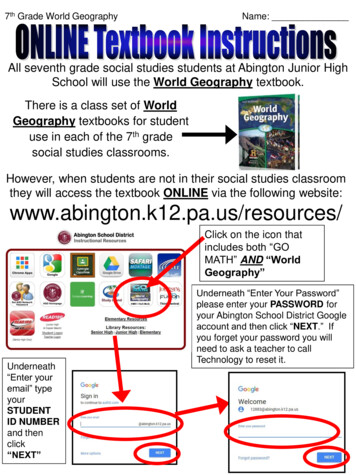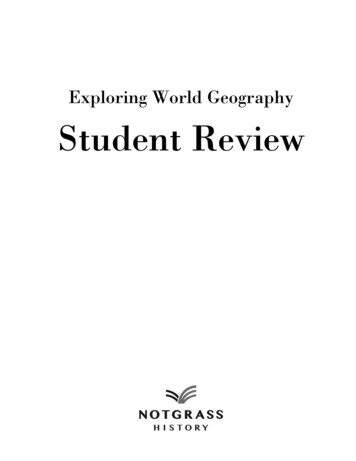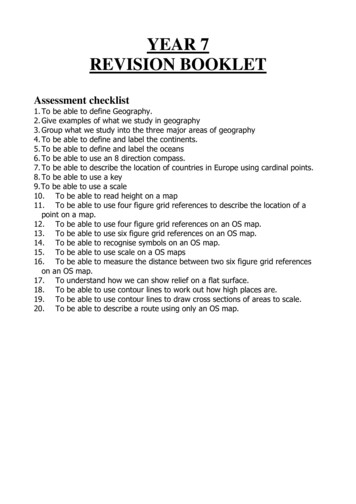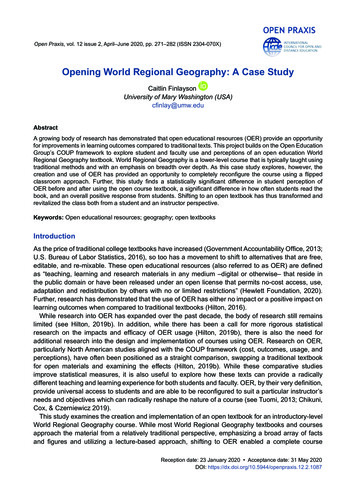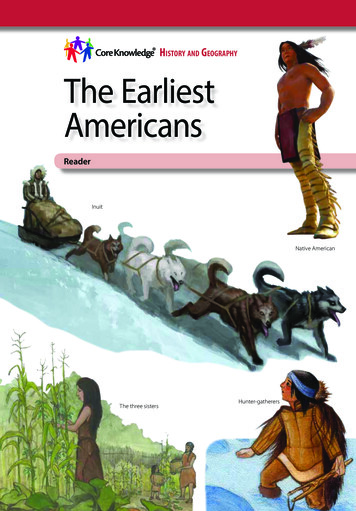
Transcription
History and GeographyThe EarliestAmericansReaderInuitNative AmericanThe three sistersHunter-gatherers
THIS BOOK IS THE PROPERTY OF:STATEBook No.PROVINCEEnter informationin spacesto the left asinstructed.COUNTYPARISHSCHOOL DISTRICTOTHERISSUED TOYearUsedCONDITIONISSUEDRETURNEDPUPILS to whom this textbook is issued must not write on any page or markany part of it in any way, consumable textbooks excepted.1. T eachers should see that the pupil’s name is clearly written in ink in thespaces above in every book issued.2. The following terms should be used in recording the condition of thebook:New; Good; Fair; Poor; Bad.
The EarliestAmericansReader
Creative Commons LicensingThis work is licensed under aCreative Commons Attribution-NonCommercial-ShareAlike4.0 International License.You are free:to Share—to copy, distribute, and transmit the workto Remix—to adapt the workUnder the following conditions:Attribution—You must attribute the work in thefollowing manner:This work is based on an original work of the CoreKnowledge Foundation (www.coreknowledge.org) madeavailable through licensing under a Creative CommonsAttribution-NonCommercial-ShareAlike 4.0 InternationalLicense. This does not in any way imply that the CoreKnowledge Foundation endorses this work.Noncommercial—You may not use this work forcommercial purposes.Share Alike—If you alter, transform, or build upon this work,you may distribute the resulting work only under the same orsimilar license to this one.With the understanding that:For any reuse or distribution, you must make clear toothers the license terms of this work. The best way todo this is with a link to this web /4.0/All Rights Reserved.Core Knowledge , Core Knowledge Curriculum Series ,Core Knowledge History and Geography and CKHG are trademarks of the Core Knowledge Foundation.Trademarks and trade names are shown in this bookstrictly for illustrative and educational purposes and arethe property of their respective owners. References hereinshould not be regarded as affecting the validity of saidtrademarks and trade names.ISBN: 978-1-68380-108-5Copyright 2017 Core Knowledge Foundationwww.coreknowledge.org
The EarliestAmericansTable of ContentsChapter 1Beringia: The Land Bridge. . . . . . . . . . . . . . . . . . . . . . . 2Chapter 2America’s First Settlers. . . . . . . . . . . . . . . . . . . . . . . . . . 10Chapter 3People of the Far North. . . . . . . . . . . . . . . . . . . . . . . . . 14Chapter 4Ancestral Pueblo and Mound Builders. . . . . . . 20Chapter 5After the Ancestral Pueblo . . . . . . . . . . . . . . . . . . . . . 30Chapter 6After the Mound Builders . . . . . . . . . . . . . . . . . . . . . . 38Chapter 7The Eastern Woodlands. . . . . . . . . . . . . . . . . . . . . . . . . 44Glossary. . . . . . . . . . . . . . . . . . . . . . . . . . . . . . . . . . . . . . . . . . . . . . . . . . . . . . 52
The Earliest AmericansReaderCore Knowledge Sequence History and Geography 3
Chapter 1Beringia: The LandBridgeAncient Hunters More than fifteenThe Big Questionthousand years ago, huge sheetsWhat was Beringia?of ice covered much of Canada andthe northern United States. In someplaces the ice was thousands of feet thick.VocabularyIce Age, n. a period inEarth’s history whenhuge sheets of icecovered large parts ofEarth’s surfaceland bridge, n. asmall strip of land thatconnects two largeland massesice sheet, n. a verythick piece of ice thatcovers a large area ofland for an extendedperiod of time2Scientists call this time the Ice Age. Much ofthe world’s water was frozen into ice. There wasless water in the oceans than there is today.Some lands that are now under water weredry. That’s why dry land once connected Asiato North America. During the Ice Age, this dryland formed an area that scientists today callBeringia (/buh*rin*gee*a/) or the “land bridge.”Although there were no ice sheets on Beringia,the weather was very cold. At that time no onein the world knew how to farm. Even if theyhad known how, it was too cold in Beringia to
During the Ice Age, much of the world’s water was frozen into ice, and theweather was very cold.3
raise anything. Only tiny plants grew there. There were no towns, nostores, and no government, just a vast, cold wilderness.So how did people in Beringia live? They had to look for plantsand animals to eat. Small groups of just a few families, perhapsThe ice sheets shown on the map were the two main ice sheets that once covered largeareas of North America.4
twenty-five to fifty people, helped eachother as they moved around in search offood. People who live this way are calledhunter-gatherers.While the women and children of the IceAge looked for plants and berries, themen and older boys hunted. They trackedherds of mammoth and musk ox backand forth across Beringia.An Ice Age BoyImagine that you are an Ice Age boy inBeringia. You are hunting with familymembers, including your older brother,Vocabularyhunter-gatherers,n. small groups ofpeople who feedthemselves byhunting animals andgathering plantsherd, n. a large groupof animals that liveand travel togethermammoth, n. a large,prehistoric elephantlike animal coveredwith hairmusk ox, n. a wildox with a shaggycoat and downwardcurving hornsTavalok. He learned hunting skills fromyour father and grandfather. Now he will teach you those skills.Beringia is your home. But there are no maps, so you don’t know thatwhen you follow the animals toward where the sun rises, you aremoving closer to a new continent—what we now call North America.Searching for signs of a herd of mammoths, your group dividesinto smaller groups of hunters. In the distance you can sometimessee the other men, also looking closely at the ground.You and Tavalok walk together, carefully looking for signs of theherd. As Tavalok crouches low on the half-frozen ground, you lookback at the path you have traveled. The land rises up. The edge of theland and sky is lost in the snow and ice. Tavalok points to the ground.5
Hunters shaped stones into sharp points that they attached to the ends of spear poles.“See those footprints,” he says. “We aregoing the right way. The herd has beenfollowing the wind.”You are carrying hunting tools, the snow isdeep, and you are tired from carrying your6Vocabularyspear, n. a long,thin weapon madefrom a pointed stick,sometimes with astone or metal tip
supplies on your back. It has been such a long journey! You havenever been away from your mother and sister for so long. Theyand other women and girls have stayed behind, gathering plantsand berries for everyone to eat.You trust Tavalok and want to learn from him. He knows how toread the sky. He can spot the animals’ tracks and other signs oftheir presence. He knows where the land dips and turns. He knowswhere the ice ends and where the land turns to stone and dirt. Heknows where to find plants.After the group manages to kill one of the mammoths in the herd,Tavalok will guide you back to find the women and children sothey can eat, too.“Our shelter is this way,” says Tavalok. “Come along now, littlebrother.”You hurry to keep up. Tavalok is already disappearing into the snow.After a while you come to the place Tavalok remembers. Your legsare stiff, and your stomach is empty. You turn and follow the rockfilled river. Then Tavalok spots other members of the group. Theyhave already built a fire. Soon all members of the group are backtogether again.Because you are so far north, the light is dim, but it is not dark. Itwill not get darker during the night.You eat the strips of dried meat you find in your bag. In the quietglow of the fire, Tavalok shapes new spear points from stone. Youimitate what he is doing.7
The hunters made camp before continuing with the hunt.“How far must we go until we reach the herd?” you ask.Tavalok shakes his head. “How quickly does the mammoth herdmove? I do not know. We will go toward the black clouds thatcover the open land,” he explains. “We will follow the tracks of theherd. I expect that after we sleep two or three more times, you willsee the place where the rocks meet the sky.”“How far will the herd go?” you ask.“It will travel to where the small plants and moss grow thick. Wewill not be far behind.”“And then will we be where the wind stops?” you ask.“I do not think we will ever go that far, little brother,” Tavalok laughs.8
Early hunters followed the herd’s tracks in the snow. Typically, they killed one herdmember. For a band of twenty-five to fifty hunter-gatherers, one mammoth provideda lot of food.9
Chapter 2America’s First SettlersWho Came First? More than fifteenThe Big Questionthousand years ago, Ice Age huntersHow did the abilityin Beringia, like the ones in the story,to grow food changewere moving into North America. But the way people lived?many scientists believe that earlierpeople may have arrived thirty thousand years ago, bysea along the Pacific Coast.At that time, hunter-gatherers could not move very far into NorthAmerica. Huge ice sheets blocked the way. About fourteen thousandyears ago, the ice sheets began to melt. The Ice Age was ending.Hunters could now follow herds of animals farther and farther intoNorth America. First they spread across most of what is now Alaska.Then they moved south, through what is now western Canada.Between nine thousand and fifteen thousand years ago, groupsof hunter-gatherers spread out through this new world. Little bylittle, they moved into the ice-free parts of North America. Theywalked everywhere—and traveled all the way to South America’ssouthern tip!10
Over a period of thousands of years, people spread over the land and settled on it.11
A New World to Live InBy now the climate was getting much warmer. Water ran offfrom the melting ice sheets, carving out giant river valleys.North America’s huge Great Lakes filled up.Melting ice water caused oceans all overEarth to rise. Many areas along the coastswere flooded, including Beringia. Therising sea cut North America off from Asia.The various groups of people found twovast continents to live in and all the animalsthey could hunt. They continued to huntlarge mammals such as the mastodon.Vocabularyriver valley, n. anarea of low landsurrounded bymountains and hills,often with a riverrunning through itmastodon, n. a large,prehistoric animalsimilar to an elephantand a mammothOver time, the climate changed, and this caused many largemammals to die out. The change in climate destroyed many of theplants the mammals ate. Overhunting the mastodon also helped toreduce its numbers.Thousands of years passed. Groups of people moved from oneplace to another. As they moved, they learned to live in their newhomes. They learned to use the resources available to them. Theydeveloped hundreds of languages. Their ways of life changed to fitthe different parts of North and South America where they lived.Today, we consider these people Native Americans.About seven thousand years ago, people in Mexico discoveredhow to plant and raise corn. Slowly, many other Native Americansbegan to grow their food. For many groups, the ability to growfood meant they could stay in one place for long periods of time.12
In some cases, they stayed in one placepermanently. In other areas, however, theclimate or soil was not good for farming.In those places the Native AmericansVocabularysoil, n. the top layerof Earth’s surfacewhere plants growremained hunter-gatherers.The first corn raised by farmers in Mexico did not look anything like the corn we eat today.13
Chapter 3People of the Far NorthThe Coming of the Inuit PeopleThe Big QuestionThink about a frozen world. It is soWhat were thefar north that for six months of thedifferences betweenyear, there are very long periods oflife in the summerand life in the winterlight. Then, for the other half of thefor the Inuit?year, there are very long periods ofdarkness. DuringVocabularythe winter, it is very dark and cold.northern lights, n.Moonlight gleams on the ice. Thesoft, colorful lightnorthern lights shimmer and arcthat appears in theacross the sky. Stars twinkle, andsky in northernlands, caused by thetheir positions change as springreflection of sunlightapproaches.During the Arctic summer, the sun does not appear to set. It does,however, dip close to the horizon, where the sky seems to meet theland. Even so, there are only about one hundred days when it is warmenough for water not to turn to ice. The warm season is too short togrow crops. But berry bushes and small flowers blossom.This northern land has been called a “frozen desert.” It is a hard place tolive in. And yet it has long been home to an ancient group of people.14
The Inuit moved from place to place while hunting.15
The ancestors of these Arctic peoplecame to North America about 2,500 yearsago. Unlike Native Americans, they arenot directly related to the BeringianVocabularyancestor, n. a relativewho lived a long timeagohunter-gatherers who lived at least fifteen thousand years ago. InCanada, the ancestors of the Arctic people are known as the Inuit(/in*yoo*it/). The word Inuit means the people.When the Inuit first came to North America, they got almosteverything they needed by hunting and fishing. They gatheredplants during the short summer. Since there are no trees in theArctic, the Inuit used driftwood. They collected the wood thatfloated on the sea or down rivers to make certain things theyneeded. They also made fishhooks, knives, and other small toolsfrom bones and flint.The Inuit built igloos as shelters when they moved from place to place while hunting.16
About two thousand years ago, otherpeoples in northern Asia taught the InuitVocabularyThe Inuit used these new weapons to huntcaribou, n. a speciesof deer native toNorth Americaseals, caribou, and polar bears. Soon,hide, n. an animal’s skinhow to make and use bows and arrows.knowledge of bows and arrows spreadfrom the Inuit to other Native American people.Living in the ArcticA thousand years ago, the Arctic climate was a little warmer thanit is today. Whales migrated along the Arctic Ocean coast. SomeInuit groups followed the whales east. They traveled from Alaskato northern Canada and all the way to Greenland. They set upvillages. This meant they could stay in one place for more thana single season. On the sea, they traveled swiftly and safely inkayaks. Kayaks were canoes made out of animal hide stretchedover a frame. The frames were made from driftwood or animalbone. On land and on the thick ice, the Inuit carried heavy loadson sleds. These sleds were pulled by a person wearing a harness orby a team of dogs.The Inuit becameskilled huntersof whales andwalruses. They usedspecial tools suchas harpoons tippedwith bone, stone,and later iron.The Inuit used dog sleds to carry heavy loads.17
The climate gotcolder again fivehundred years ago.It got too cold forwhales to swim alongthe Arctic coast. TheInuit in Arctic Canadaand Greenland couldno longer live in oneplace all year. Duringthe year they movedThe Inuit lived in small groups and hunted a varietyof animals.from place to place to find enough food to eat. They broke intosmall groups. They hunted smaller animals, such as seals. Sometraded with Europeans, who were beginning to explore the Arctic.A Year in the Life of the InuitDuring the winter, the Inuit crossed the ice to hunt caribou andseal. Some Inuit used blocks of snow to build shelters or homescalled igloos (/ig*loos/). Families couldlive in an igloo. These frozen structureswere sometimes connected by halls andtunnels. Families gathered to share stories,songs, and celebrations.Vocabularyigloo, n. a domeshaped temporaryshelter made fromsnow blocksIn the spring, the Inuit often traveled to inland rivers to fish fortrout. As the ice melted, they could travel on the sea by kayak.Then, during the summer, tents made of animal hides replaced theigloos. The Inuit set up their camps on dry, high ground. Strongwinds kept insects away. They used plants and berries growing18
on the treeless land of the Arctic for food,fuel, and medicine. Some traveled farfrom the coast in summer, hunting herdsof caribou.Vocabularyfuel, n. a substancethat is used to createheat or energyIn the fall, the Inuit returned to the coast to hunt seals, walruses, andwhales. They built shelters near the coast. These shelters were madeof rock-lined pits covered with earth. Families burned oil made fromwhale or seal fat for light and heat. They also used the oil for cooking.Throughout the year, Inuit families stored as much food as they could.Today, many Inuit live in communities that are more like yours.They travel by snowmobile instead of dogsled. Their kayaks aremade of a light material called fiberglass instead of animal skins.They wear nylon parkas. But they also follow many of their ancienttraditions. They understand the ties to the land, the sea, and theanimals that helped them survive for thousands of years.Each season brought about changes to how the Inuit lived.19
Chapter 4Ancestral Puebloand Mound BuildersMeet the Cliff Dwellers It is latein the day. A young boy stands andwatches the world around him. He iswaiting for his father to return froma hunting and trading trip. The boywill be glad to see him.The Big QuestionHow would youcompare thesettlements built bythe Ancestral Puebloto those built by theMound Builders?As the boy watches, he hears the rhythmic sound of his sistergrinding corn for the evening meal. He hears his other sistersVocabularymaking baskets and decorating clay pots.His youngest sister sings with a clear, sweetcliff dweller, n. aperson who lives on arock ledge or cliff wall,such as a member ofthe Ancestral Pueblopeoplevoice that echoes through the canyoncanyon, n. a deepvalley betweenmountains, cutthrough the rock byriver waterjars. His little brother is there too, playing in20below. Maybe their father will hear her andhurry home.Down at the creek, his mother fills the waterthe still water. The boy knows that in yearswhen it rains a lot, the creek swirls andsplashes over the flat stones. Also in wet years,
The cliff dwellings were like small towns.21
During the wet years, corn was plentiful.the winter brings snow to the high country, where they live.Then the corn grows tall and the squash grows thick. The roomswhere the food is stored are filled with jars of beans and basketsof corn.Dry YearsBut some years the winter snows and summer rains don’t come.In those years, his parents worry whether there will be enoughfood for their village. When it’s dry, his father worries he won’t findmany animals when he goes hunting. In the dry years, the animalsmove to places with more water to drink and more plants to eat.22
The boy’s grandmother is the oldest person in the village. She saysthat there have always been wet summers and winters with lots ofsnow—and also winters and summers when it was dry. But nowshe says that there seem to be more dry years than ever before.What is happening? The people don’t know, but they are worried.Now smoke from the evening fire curls through the upperrooms. The sky darkens. The boy knows now that his father willnot return tonight. Maybe he had to hunt so far from the villagethat he camped along the trail. Maybe he has found a placewhere the land is rich and the water is clear, where the peoplecan build a new home. The boy will have to wait for news. Heclimbs down a ladder to join his grandmother, mother, sisters,and little brother.The young boy in this story lived onethousand years ago. His people were theancestors of the Pueblo (/pweh*bloe/)groups that today live in an area called theFour Corners. This is where the present-dayVocabularyPueblo, n. a groupof Native Americanpeople who live in theAmerican Southweststates of Arizona, New Mexico, Utah, and Colorado meet.The boy’s home was a village built into the side of a cliff, highabove the stream at the canyon bottom.Rooms were stacked on top of each other like an apartmentbuilding under the overhanging cliffs. Ladders connected thedifferent levels of the cliff dwellings.There, villagers went about their work. They wove clothing. Theymade sandals from strips of animal hide and yucca. Yucca is a23
southwestern plant with tough leaves. The villagers also madejars, bowls, and pitchers out of clay. They cooked squash, corn, andbeans over open fires.The Ancestral PuebloWe don’t know what the boy’s people called themselves. TheNative Americans who now live in the Southwest call these ancientpeople the Ancestral Pueblo.The existence of the Ancestral Pueblo in the American Southwestgoes back at least two thousand years. At first, they hunted gameand gathered seeds, berries, and plants. Eventually, they began toplant crops near the streams in the valleys below the cliffs.The Ancestral Pueblo were skilled basket weavers and potters.24
The first native people of the Americas who raised corn livedin Mexico about seven thousand years ago. Over time, variousgroups of people in the Americas, such as the Ancestral Pueblo,also added corn to the crops they raised.Because the Ancestral Pueblo raised crops for part of the year,they set up farming villages. As well as corn, they grew beans andsquash. But they did continue to hunt and to gather wild plants.Women and girls had the job of raising crops and gathering wildplants. Men still mostly hunted and traded.Ancestral Pueblo VillagesAs the population grew, the Ancestral Pueblo spread over a widearea in the Southwest. They began building villages in severaldifferent styles, including the cliff houses like the one the boy in thestory lived in. They made some buildingswith stone or adobe (/uh*doe*bee/), whichVocabularywas made of clay. All of the buildingsadobe, n. a typeof brick made fromsundried clayincluded places for sleeping and for storingfood. They also had places for meetings,religious ceremonies, and celebrations. Outdoor plazas or porchesconnected the living areas. One style of building was two or threestories high. The flat roof of one story formed the porch for the storyabove. Ladders connected each level.The Ancestral Pueblo also built paths and trails to connect thesettlements where they lived. With other groups, they tradedpottery, woven goods, jewelry, and tools.25
What Happened to the Ancestral Pueblo?For hundreds of years, the Ancestral Pueblo lived as cliff dwellersin an area of the Four Corners. Suddenly, they were gone. Whathappened? We don’t know. Scientists have several different ideas.Farming can be very hard. Plants needlight, warmth, and water to grow. Theyalso need minerals in the soil to behealthy. Over many years, the AncestralVocabularymineral, n. a naturallyoccurring substancefound in Earth’s crustPueblo may have worn out the soil.The weather also may have changed. Without enough rainfall, it isdifficult to grow food to eat. The animals used for food struggle tosurvive, too.No one knows for sure why the Ancestral Pueblo left.26
Something made the Ancestral Pueblo leave their cliff dwellingsand move. We may never know exactly what it was. Today,the Pueblo people who live in small groups throughout theSouthwest trace their roots to the Ancestral Pueblo, the cliffdwellers of long ago.The Mound BuildersJust as the Ancestral Pueblo did, other ancient Native Americanslearned to live in a way that seems very mysterious to us today.One such group of people was called the Mound Builders.They once lived near rivers in what is now the Midwest and inthe Southeast. Their way of life beganabout 2,800 years ago. This was aboutVocabularythe same time as the civilization ofmound, n. a large,rounded pileancient Greece.Like the Ancestral Pueblo, the Mound Builders were farmers.They grew corn, squash, and beans. Because they were farmers,the Mound Builders settled in one place. They raised so muchfood they could trade with other groups. They built cities, roads,and marketplaces.Building a TownLet’s watch the Mound Builders as they build a town. Usingbaskets, they collect dirt and heap it up into huge piles to formflat-topped mounds. The tallest mounds are several stories high!Then they put buildings on top of the mounds. The buildingsmight be temples or houses.27
The Mound Builders’ villages stretched along the Mississippi RiverValley. Their villages spanned from the present-day states of Ohio,Wisconsin, and Minnesota to Louisiana and the southeasternUnited States.What happened to the Ancestral Pueblo cliff dwellers is stilla mystery. We do, however, know what happened to some ofthe Mound Builders. The cities of the Mound Builders lastedfor hundreds of years. During this time some groups of MoundBuilders became very powerful, while others fell from power.Then came the arrival of European explorers in the 1500s.The people of the Mississippi Valley could not fight off the germsand diseases carried by the Europeans. In a very short time, theybegan to die rapidly.Survivors of the Mound Builders became the Native Americannations known today as the Creek, the Cherokee, and the Choctaw.In the late 1600s, French explorers saw the last Mound Builder cityin what is now Mississippi. It was ruled by a wealthy, powerful king.But by the early 1700s, this city was gone, too.28
The Mound Builders used piles of dirt to build mounds of different sizes.The community held ceremonies, meetings, and games in a central plaza. The mostrespected and most important people in the village lived on the tallest mounds, close tothe plaza.29
Chapter 5After the AncestralPuebloThe Pueblo Native people andscientists agree that the descendantsof the Ancestral Pueblo cliffdwellers include the Pueblo. Today,these people live in the AmericanSouthwest.The Big QuestionWhat are some of thereasons why someNative Americangroups moved fromplace to place?In Spanish, the word pueblo means village. In the 1500s and 1600s,the first Spanish explorers arrived in the Southwest. There they metthe native people. The Spanish named these people for the villageswhere they had lived and farmed for hundreds, even thousands,of years.Pueblo villages look like they’re modeled after Ancestral Pueblo cliffdwellings. Like the Ancestral Pueblo, the Pueblo built apartment-stylehomes out of adobe bricks.This is one reason scientists feel certain that the Pueblo people arerelated to the ancient Ancestral Pueblo cliff dwellers.30
One group of Pueblo people named the Hopi built their villages on the topsof mesas for protection from enemy attacks.31
Like the ancient Ancestral Pueblo, the Hopi built homes with different levels connectedby ladders.Nineteen Pueblo villages still exist. Theycan be found on the high mesas(/may*sahs/), in the deep canyons, andalong the river valleys of New Mexico. AllPueblo villages share many traditionsVocabularymesa, n. from theSpanish word fortable, a rocky,flat–topped hillpassed down from their ancestors. But each separate village alsohas its own special customs.The Hopi and the ZuniThe Hopi (/hoe*pee/) are Pueblo people. They stayed in the highdesert or on the plateau areas of Arizona, just like their ancestors.They built villages on the high mesas. There they grew corn,squash, beans, and melons. The word Hopi comes from a phrase32
that means the peaceful people. Today, the Hopi live mostly innortheastern Arizona.The Zuni (/zoon*ee/) are also Pueblo. They live in the western partof New Mexico. The Zuni do not share a language with the otherPueblo groups.The NavajoFor tens of thousands of years, groups of Native Americans havemigrated. Some moved to follow game. Some moved becausethe climate changed. Some moved to findmore or better land. Others were drivenaway by enemies. Whenever people move,they bring some things with them. TheyVocabularygame, n. animals thatare hunted for sportor for foodleave other things behind.The Navajo (/nah*vah*hoe/) migrated from northern Canadato the Southwest. In their language, they call themselves Diné(/dih*nah/), meaning the people. The Navajo language links themto their ancestors in Alaska and Canada. Perhaps the Navajo aredirectly related to the hunter-gatherers who lived in Beringia manythousands of years ago.The Navajo who came to the Southwest from Canada fought with thePueblo who had lived in the Southwest for thousands of years. Butthe Navajo also learned from the Pueblo. They learned how to survivein the harsh climate of the high desert. For example, the Navajo oftenused adobe to build their homes. But they built individual domedhouses in small, scattered groups, rather than in villages.33
The Spanish firstbrought sheep tothe Southwest in the1600s. As a result,raising sheep became abig part of the Navajoway of life. The Navajobecame more settled.They used fleecefrom their sheep tospin wool and weaveblankets and rugs.Still known for theirweaving skills, todayAfter being introduced by the Spanish, sheep becamean important part of Navajo life.the Navajo make up the largest Native American nation in theUnited States.The Apache and the ComancheLike the Navajo, the Apache (/uh*pach*ee/) also migrated fromnorthern Canada to the Southwest. They traveled along theeastern side of the Rocky Mountains. Apache territory coveredparts of present-day Texas, New Mexico, Arizona, and northernMexico.The Apache hunted and traded. Later, after the Spanish broughthorses to America, the Apache learned how to ride the newanimals. Horses made it easier for the Apache to hunt and to raidrival Navajo villages, as well as to attack Spanish forts.34
The Spanish introduced horses to the Americas, and the Apache learned to use these newanimals. The Apache hunted on horseback. They used buffalo hides to make tepees.35
The Comanche (/kuh*man*chee/) were the only NativeAmerica
thousand years ago, Ice Age hunters in Beringia, like the ones in the story, were moving into North America. But many scientists believe that earlier people may have arrived thirty thousand years ago, by sea along the Pacific Coast. At that time, hunter-gatherers could not move very far into North America. Huge ice sheets blocked the way.
